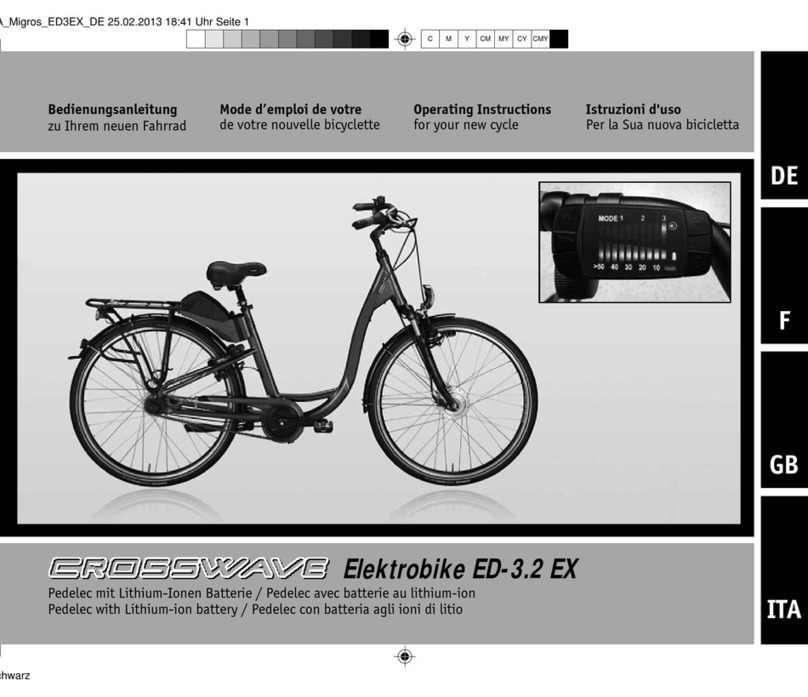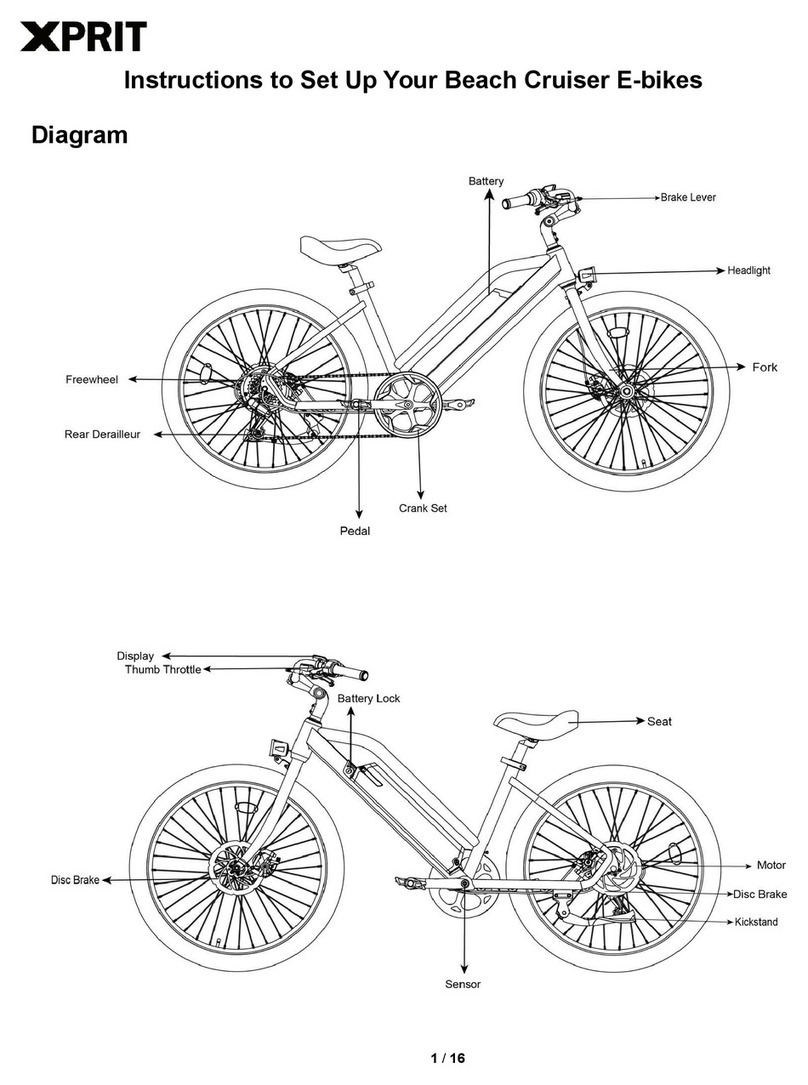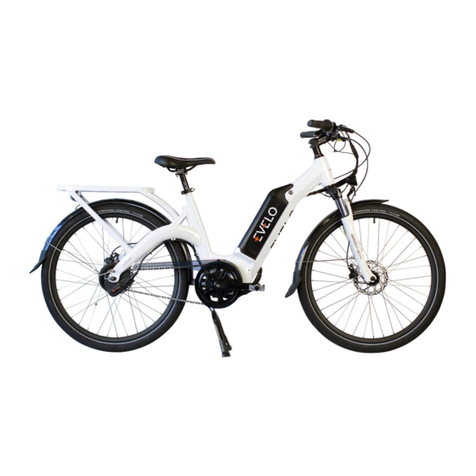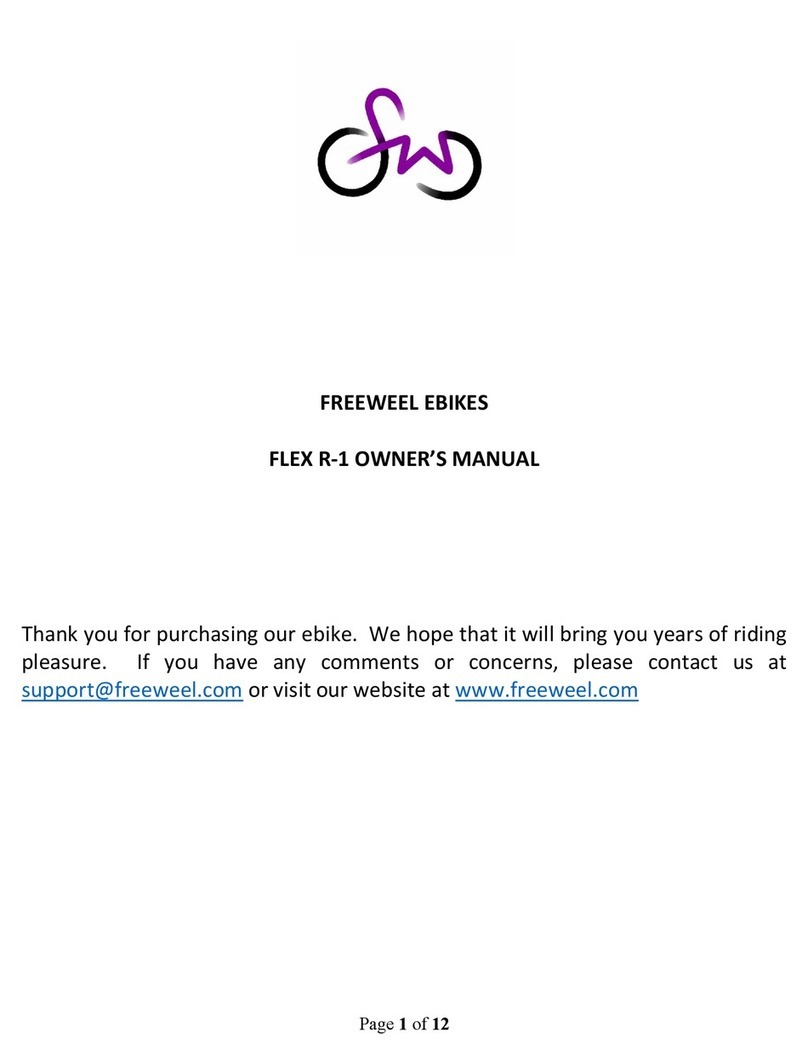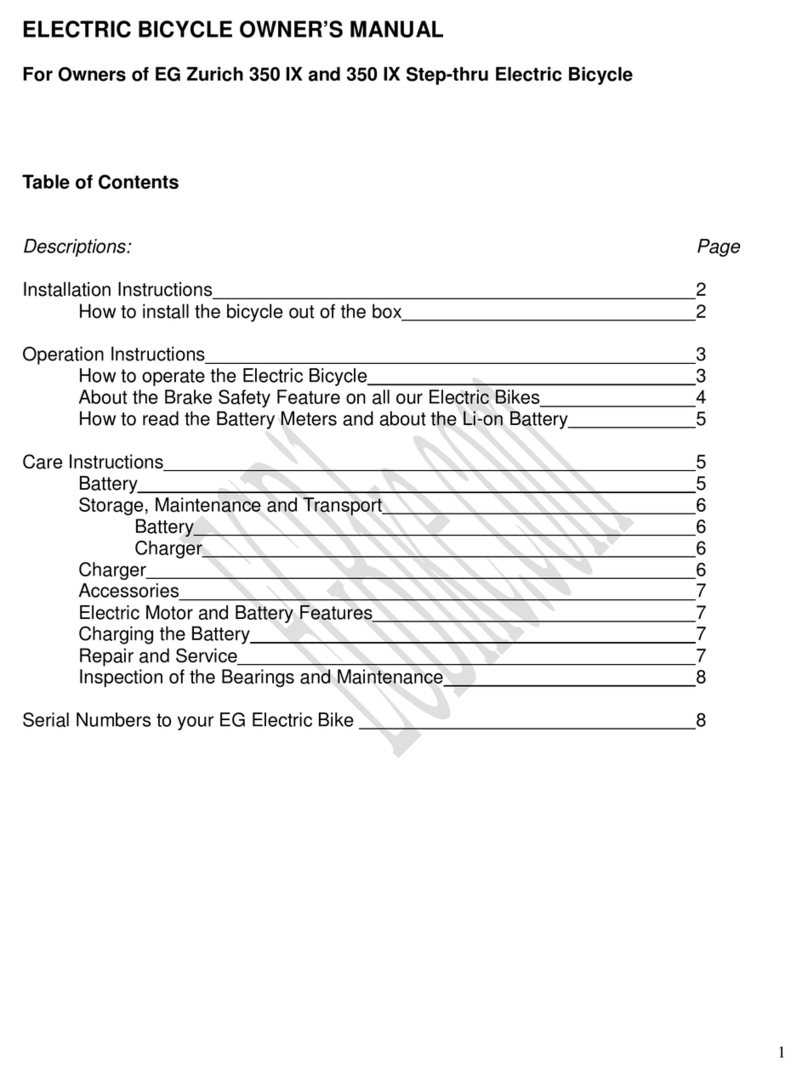Myride LSF008 User manual

EBIKE LSF008 Owners Manual

Before assembly, please check that you have all the parts below:
An owner’s manual, a battery charger, a set of tools
Contents

13

In order to ensure cycling safety and maximum performance, fasten and check the bolts in key places.
Name of Clamp Bolts
Standard Torque /N.M
Bolt for Handlebar
1 bolt / 2 bolts
M5
16-25N.M
M6
25-35 N.M
4 Bolts
M4
10-15N.M
M5
16-25N.M
M6
25-35 N.M
Handlebar Expanding Bolt
M6
25-35 N.M
M8
25-35 N.M
Handlebar Stem and Fork Clamp Bolt
M5
16-25N.M
M6
25-35 N.M
Sunflower Fixing Bolt
4-6 N.M
Saddle
M6
25-35 N.M
M8
35-50 N.M
Seat-pillar Fixing Bolt
M4
10-15N.M
M5
16-25N.M
M6
25-35 N.M
Front Wheel
25-30 N.M
Rear Wheel
40-45 N.M
Rear Rack
M5
16-25N.M
M6
M10
25-35 N.M
45-60N.M
Derailleur
Assembly Instructions

Before assembling your EBIKE LSF008, you should charge the battery fully. This will allow you to test the
electrical connections during assembly. It may take up to 6 hours to fully charge the battery. The charge light
turns from red to green when it is fully charged. Please note, the battery will deteriorate if it is left uncharged.
01
02
03
Open and charge the battery
You can then take the battery out and charge it with the charger
supplied. You can also charge the battery independently.
Use the key and open the battery.
Pull out the battery as shown in the photo.

The handlebars are already attached to the frame via cables.
The structure of the brake handle is as shown, the left brake
handle controls the front brake, and the right brake handle
controls the rear brake.
Please pay attention to the Minimum insertion mark on the
handlebar stem to insure the rider safety.
Press the button to fold the pedals.
The pedals are market left [L] and Right [R]
The left- and right-hand side is when you are
sitting on the bike facing forward. Screw each
pedal into the appropriate pedal shaft by hand,
and then tighten with a spanner to secure into
place.
02
03
01

Use one hand press the button under the folding catch and
use the other hand to fold the frame.
After you unlock the frame you can start folding.
Unfolding the frame
02
03
Folding the Frame
01

The material of product shell is ABS + PC. The material of the window is 2.5D tempered glass.

3
1
5
4
1.The mode indicator
2.The lighting indicator
3.The battery level indication
4.The text area indicator
5.The speed indication
2

01 •Tyre Inspection
1. Tyre pressure Pressure of the tyres should be judged according to Tyre condition and level of comfort
required. In case of abnormal pressure, a tyre pressure gauge should be used for inspecting and adjusting to the
required pressure. Generally, normal pressure of front wheel is 250Kpa (40 PSI).
2. Check that the tyres have no fracturing or abnormal wear.
3. Check whether there are embedded nails, stones, or glasses in the tyres.
Caution: steering failure and tyres bursting, are caused by abnormal tyre pressure, cracked, damaged and
abnormal wear of the tyres.
4. The tyre should be replaced, when depth of tire groove and bump of the tyre have been worn down by 2/3.

•Lights Inspection
1. Operate lighting switch to check whether front light and taillight are ON and whether beam of front light is normal.
2. Check the front and the rear brake handles respectively to see whether the power is disconnected.
3. Please be sure to check whether the light is damaged, to ensure rider safety.
1. Swing the handlebars to the upper, lower, left, right, front, and back, to see
whether anything is loose. Tightened any loose screws.
2. Determine if front and rear wheels are secured correctly.
3. Check the handlebar Minimum insertion location prior to riding
03
Inspection before riding
•Handlebars, front and rear wheels Inspection
02

04 •Other Inspections
1. Brakes: (Left brake lever control rear wheel, Rightbrake levercontrol front wheel)
Make sure your brakes are always adjusted correctly.
Adjustment can be made at the wheel rim/brake mechanism with the required tools. Fine tuning of the brakes
can be made via adjustable twist screws, which are located at the join of the brake lever to the cable.
Replace the brake pads when worn.
2: Saddle
For maximum comfort ensure that the saddle is
both correctly adjusted and secured.
Once set up correctly, the height of the saddle
can be adjusted without tools.
The bike is better ridden by people that are between a height of
150cm-200cm.
Inspection before riding

3. Saddle post :
Loosen the lever at the top of the frame below the
saddle to raise or lower the
saddle post,Once the saddle is at the required
height, secure it by tightening
the lever. Tighten or loosen the nut on the lever if
required.
1.Battery casing 2.Charging socket 3.Battery status button
2
Inspection before riding
3. Saddle post:
Loosen the lever at the top of the frame below the
saddle to raise or lower the
saddle post, Once the saddle is at the
required height, secure it by tightening.
Tighten or loosen the nut on the lever if required.
3
1

3. Saddle post:
Loosen the lever at the top of the frame below the
saddle to raise or lower the
saddle post. Once the saddle is at the required
height, secure it by tightening
the lever. Tighten or loosen the nut on the lever if
required.
Inspection before riding

•Other Inspections
1. Brakes, Gears, Shift lever and Bicycle Chain:
Change through the gears one at a time and only when the bicycle is in motion. To maintain performance,
ensure that all the mechanical parts of the gears are lightly oiled (avoid getting oil deposits on the wheel rims). If
the chain mechanism becomes dislodged, turn the pedals forward gently to engage it. If the chain becomes
completely dislodged, re-engage it on the smallest gear cog.
The gears or derailleur should only be shifted as you are pedalling to keep the derailleur in adjustment. The
derailleur / shifting and pedalling, are completely independent of the motor. As much as possible, avoid
changing the gear-speed ratio substantially and you should change the speed in accordance with the order. If
you do not feel confident setting up the gears, it is recommended you take the bicycle to a workshop for
assistance.
2: Helmets:
Helmets are a legal requirement when riding a bike, we recommend that you do so for your safety. Wearing
a cycle helmet has been proven to reduce the likelihood of head injuries.
3: Handlebar stem, Wheel
Make sure the handlebar stem is straight and aligned and check the wheels are in good state.
4: RIM
Two black lines on the rim are safe lines(as per photo),when these two lines are not clear, please replace.
Inspection before riding

1. Regulations
Follow the rules of your country to ensure riding safety.
2. Start
Long-press M key to start up and check whether each function works and whether the brake lever is
normal. If there is no abnormity, the kickstand should be placed horizontally into lock position prior to riding
your bike.
3. Shifting system
Gear shift lever is located at the right handlebar. According to personal riding demand, upper and lower
controllers can be changed to set the required gear, so as to achieve the effect of changing riding speed and
comfort level. Regarding braking, first brake the rear wheel and then brake the front wheel.
Caution:It’s dangerous to only use the front brake or the rear brake, as it may cause sideslip of the e-bike.
4. Stop methods
Slow down and approach the parking place.
Long-press M key to turn off the power supply, only when the bike has totally stopped.
Safe riding

•Do not use it as an off-road bike. You will be get hurt if not used correctly.
• Riding with battery, make sure temperature is - 10°~60°.
•Please remove the battery during the maintenance. You are not able to alter the Power Management System.
•When these parts are working, it will generate high temperature which may cause injury. For example Brake
discs after a long ride, or after charging the battery for a long period of time.
•Please follow these instructions carefully-Open the seat lock to adjust the height of seat, make ensure you
comfortable when riding. Once the saddle is at the required height, secure it by tightening the lever. Tighten or
loosen the nut on the lever if required to ensure correct seat position.
•When riding while it is raining, the brake distance will be greater, so please keep a longer safe braking
distance and reduce your speed.
•Max loading :120kgs
•Please abide by local laws and standards for night riding.
•The correct adjustment of quick release: Put the pins onto the front fork
•Place the wheel between the forks, then fasten the nuts and washers to each side of the wheel
•Press the lever to secure the nuts firmly to the forks. The wheel needs to spin freely, so avoid over tightening.
•This e-bike has a maximum loading capacity of 120kg.
•The noise emission sound level is less than 70dB[A].
Attention

dd)An advisory note to draw attention of the rider to possible damage due to intensive use and
to recommend periodic inspections of the frame, fork, suspensions joints (if any), and composite
components (if any). The advice may be as follows;
WARNING 1—As with all mechanical components, EPAC is subjected to wear and high stresses.
Different materials and components may react to wear or stress fatigue in different ways. If the
design life of a component has been exceeded, it may suddenly fail, possibly causing injuries to the
rider. Any form of crack, scratches or change of colouring in highly stressed areas indicate that the
life of the component has been reached and it should be replaced.
WARNING 2—For composite components impact damage may be invisible to the user, the
manufacturer shall explain the consequences of impact damage and that in the event of an impact;
composite components should either be returned to the manufacturer for inspection or destroyed and
replaced.
For composite components, an advisory note to draw attention to the influence of high
temperature (heat radiations) in confined environment on composite materials (if appropriate);
.
Notes

•Press down the shifter lever to Change through the gears one at a time and only when the bicycle is in
motion. To maintain performance, ensure that all the mechanical parts of the gears are lightly oiled (avoid
getting oil deposits on the wheel rims).
•Please periodically check the frame, fork, and other parts to ensure rider safety.
•When cleaning, prohibit cleaning the frame directly with the water or any other liquid, it may lead to the electric
parts short circuit, damaged or fire. It is recommended to cut off the power switch and remove the battery and
then use wet cloth to wipe the bike surface when cleaning the bike. Prohibit using other corrosive liquids to clean
the bike itself.
•The chain, fluted disc, flywheel, derailleur should be always washed, wiped, and lubricated. Using a light
machine oil (20W) and the following guidelines, lubricate the bicycle:
Pedal
Every 6 months
Put 4 drops of oil where catch pedal axle goes
into the pedal
Chain
Every 6 months
Put 1 drop of oil on each roller of the chain
B.B.
Every 6 months
Contact a professional technician
Motor
Each year
Contact a professional technician
Attention

1. Brakes notworking effectively
Check the distance between the brake blocks and the Wheel / Rim.
Check that the blocks are parallel with the Wheel / Rim.
Check for any wear on the brake pads
Fine tuning to the brakes can be performed by the adjusters between the brake lever on the handlebars and the
brake cable.
Major adjustments are made at the brake pads and you will need the appropriate tools. See brake assembly
instructions.
2. Motor notworking
Check that the ignition has been switched on.
Check that the battery is properly inserted in its housing.
Check that the battery is charged.
Check that none of the electrical cables and connections has become dislodged.
3. Light(s) notworking
Check that the wiring is not broken.
Check that the bulbs are inserted correctly.
Check that all connections are made properly.
Troubleshooting
Table of contents
Popular Bicycle manuals by other brands
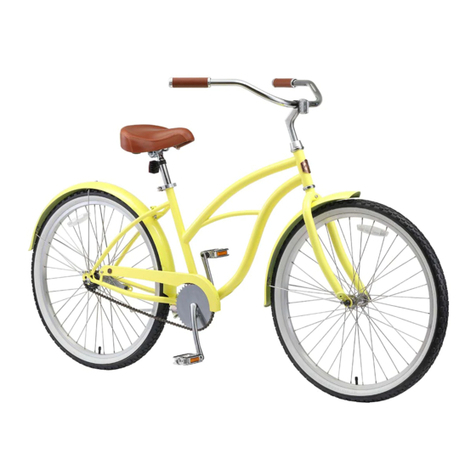
A/O Bicycle
A/O Bicycle AMELIA Assembly guide

Belize Bicycle
Belize Bicycle BUDDY TRIKE Installation & user manual

I-Bike
I-Bike CITY EASY URBAN instructions
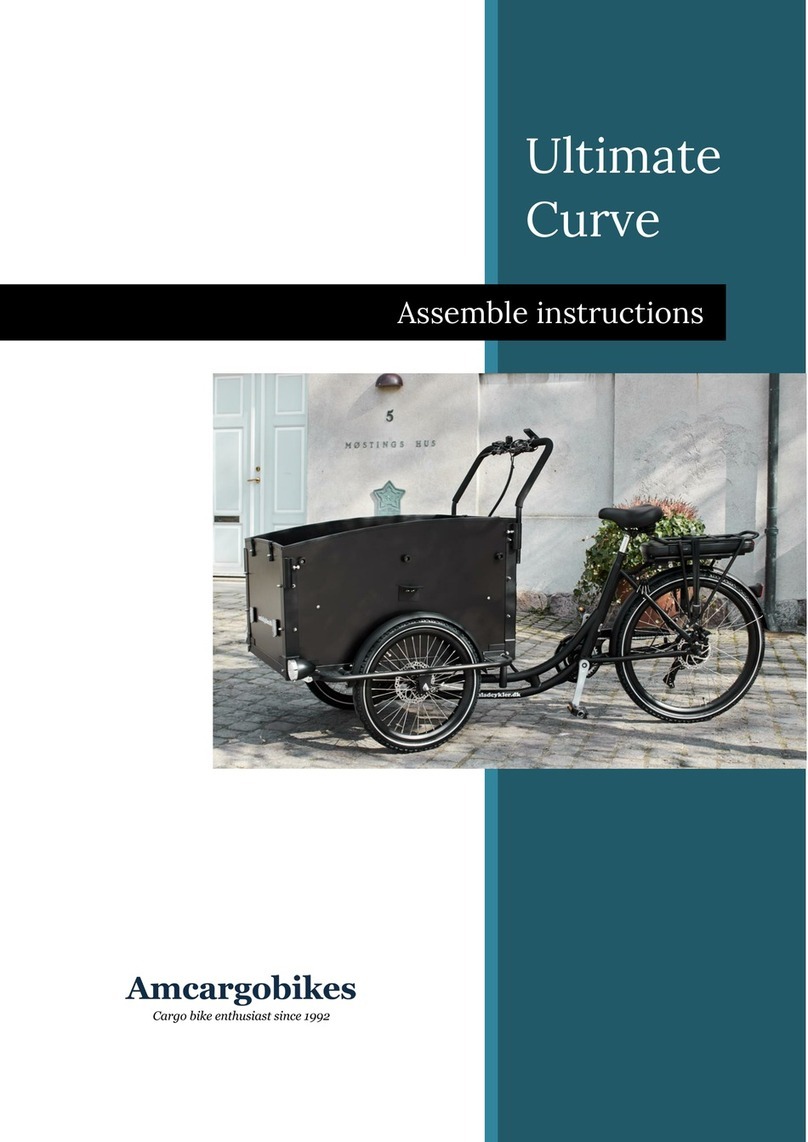
Amcargobikes
Amcargobikes Ultimate Curve Assemble instructions
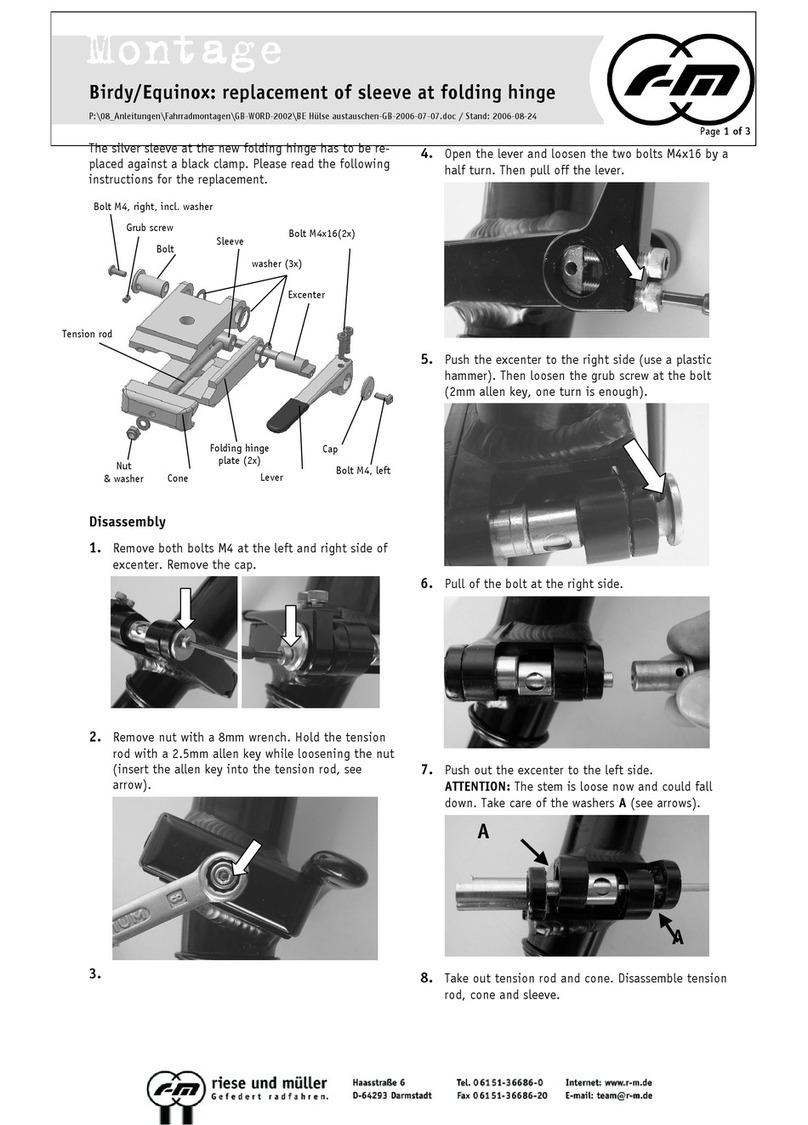
RIESE & MULLER
RIESE & MULLER Birdy Replacement manual
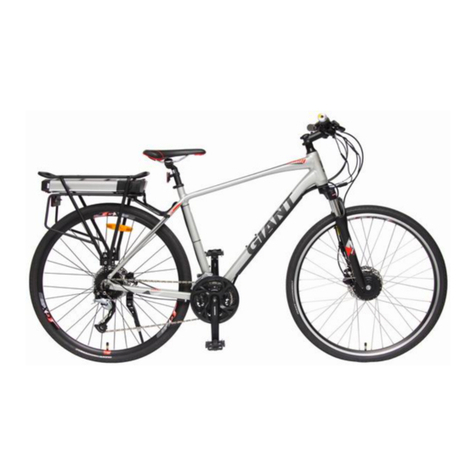
Tebco
Tebco HURRICANE 2022 owner's manual

